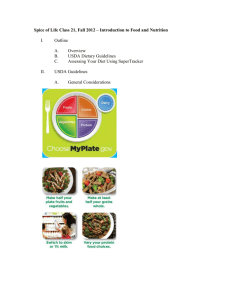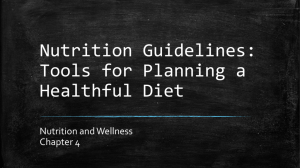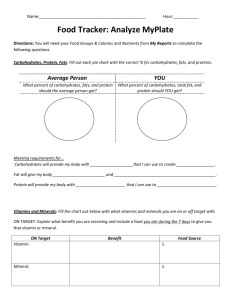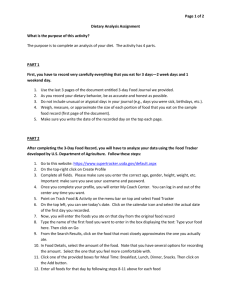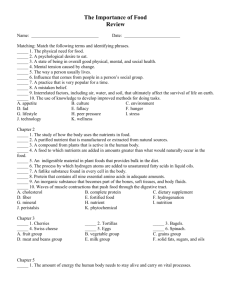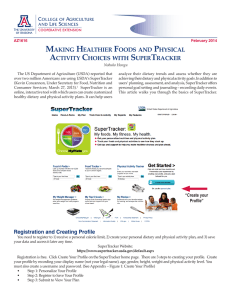SuperTracker Food Analysis
advertisement
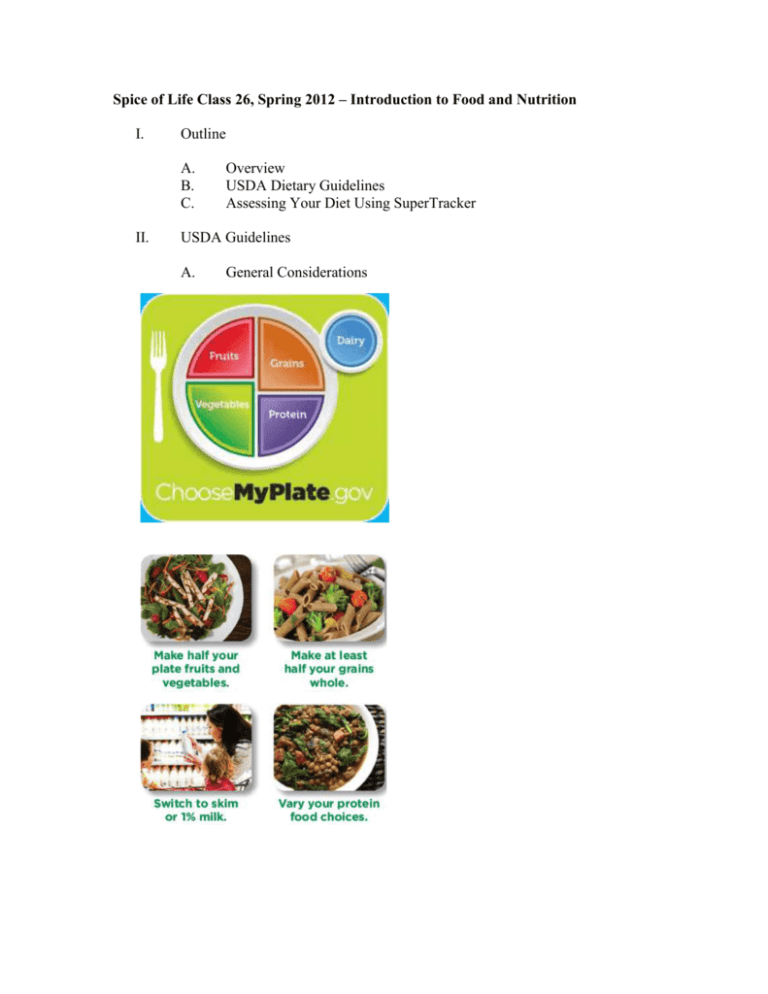
Spice of Life Class 26, Spring 2012 – Introduction to Food and Nutrition I. Outline A. B. C. II. Overview USDA Dietary Guidelines Assessing Your Diet Using SuperTracker USDA Guidelines A. General Considerations III. Food Diary Activity: SuperTracker Food Analysis A. Part I: Are you regularly meeting your dietary guidelines? 1. 2. Go to https://www.choosemyplate.gov/SuperTracker/ Create a Profile using the tab at the upper right of the page. 3. After you have registered, go back to the SuperTracker home page, log in and click on “Food Tracker >”. You will be taken to a page that will track all kinds of information about what you eat on a daily basis. Along the top of the page you will see boxes with your Daily Calorie Limit (based on your age and weight), the amount of calories you have eaten, and the amount you have remaining. To the right of that, you will see your targets for Grains, Vegetables, Fruits, Dairy and Protein Foods. We will ONLY be tracking the latter items (not calories) for classroom purposes. 4. Below the Daily Calorie Limit Box you will see a search window for food items. To begin to enter your food for a day type the food item in the search window and click on “Go”. When I type ‘egg’ into the box, I get 261 possible choices. 5. Choose the form of your food from the list that best matches what you ate. If a perfect match is not available, try again with a new search term until you find something close. Brand names are not always available, so you may need to just search by the food type. 6. When you click on your food choice, the nutritional information for that food will appear on the screen. The nutritional information for my poached looked like this. Next I clicked on ‘breakfast’ and ‘add’, and the poached egg was added to my foods for the day. Note that the nutritional information includes the food group (s) that eggs belong to (protein foods), total calories, ‘empty’ calories (you get a maximum number of these per day), solid fats, added sugars, saturated fat and sodium. 7. Once I have added the egg to my food for the day, many things change. My Daily Calorie Limit and Daily Food Group Targets reflect the egg (note Protein Foods now have 1 oz): My Daily Limits are now also adjusted. I have eaten 19 of my allowed “empty” calories, 2g of my limit of 20g of saturated fat, and 147 mg of my limit of 2300 mg of salt. 8. 9. 10. Continue to add food for the entire day and then summarize that day’s information on the chart on the next page by entering the total amount (in ounces, cups or grams, as appropriate) of each item that you ate, in the top box (in the row next to the T) and then placing a smiley face (if you had a good amount) or a frowning face (if you had bad amount) of a limited nutrient or of a daily food group in the lower box (in the row with the smiley face). Repeat for the entire week. Put a star next to the major food groups that you seem to get enough of on a regular basis (you got a happy face at least 5 times during the past week). SuperTracker Worksheet Name:_________________________________________ T T T T T T T B. Calculating your Nutrient Intakes 1. 2. Now go to My Reports at the top of the page and choose Nutrient Reports. Choose the dates for the week that you tracked, and click on ‘Create Report’. You will see a listing of all of the major USDA nutrients. Write down your target amount, and then write down the average amount you ate and your status. Target Minerals Average Eaten Status Calcium Potassium Sodium Copper Iron Magnesium Phosphorus Selenium Zinc Vitamins Vitamin A Vitamin B6 Vitamin B12 Vitamin C Vitamin D Vitamin E Vitamin K Folate Thiamin Riboflavin Niacin Choline 3. Choose 3 vitamins or minerals from the table that your diet lacked. If you do not have 3 nutrients that were out of balance, do this activity for the ones that were out of balance, and then complete the activity with any others that interest you (up to a total of 3). Click the little + box next to that nutrient name in the SuperTracker table and answer the following questions. Name of nutrient 1: What is it (Brief summary) What Foods provide it? Which of these foods are you willing to eat regularly? What is its role in health and disease prevention? (Brief summary) Name of nutrient 2: What is it (Brief summary) What Foods provide it? Which of these foods are you willing to eat regularly? What is its role in health and disease prevention? (Brief summary) Name of nutrient 3: What is it (Brief summary) What Foods provide it? Which of these foods are you willing to eat regularly? What is its role in health and disease prevention? (Brief summary)
